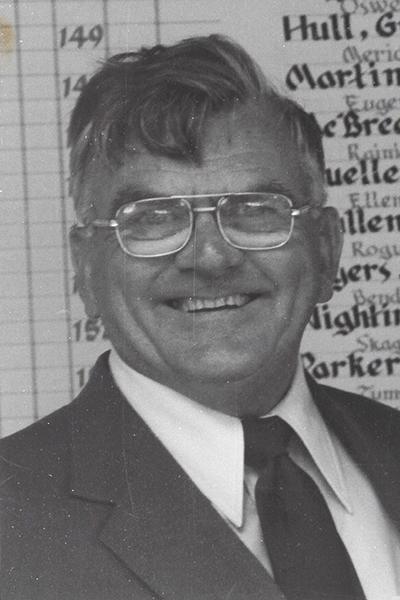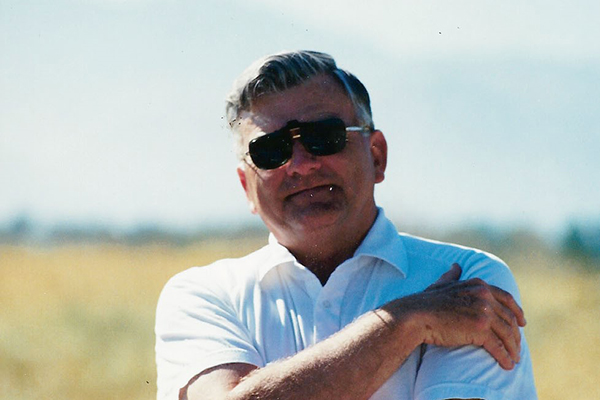Charles Draper Sr., who led the Washington State Golf Association (now WA Golf) as president in 1979-1980 and as executive director from 1986-1991, passed away on October 13, 2021. He was 96.

Charles served in some sort of WSGA capacity for nearly three decades, spending time on the association’s board of directors and becoming secretary treasurer, vice president, president, assistant executive director and finally its top leader. In all these years of service, he never took a salary.
Charles was born August 6, 1925 in Seattle, Wash. as the only child of Frank and Marian Draper. He grew up on Ida Street and roamed the forest of West Seattle and Lincoln Park in the 1930s. As a young boy, Charles worked at Draper Engine Works for his dad and grandfather.
He graduated from West Seattle High School and continued to work at the family business where he designed and created many innovations for the boating, fishing, and lumber industry as well as fixing problems of building mechanics, such as the Space Needle.
He joined the Navy during World War II, where he would use his talents as a machinist while seeing action in Guadalcanal. He was in charge of the boat motor pool keeping them running and piloting small craft and landing craft.
After the war, he began his University of Washington studies in mechanical engineering. As an artist as well as a perfectionist, Charles would explain anything with a pencil in hand. Whether it be a machine design, or a how-to in the machine shop, sports, music, building or designing anything, there was always a napkin nearby on which he would sketch out an explanation.
He began playing golf in 1954, when he first picked up a golf club at the insistence of a friend, Dick LaBelle, who was an assistant teaching professional at West Seattle Golf Course. Charles turned his intellect and focus toward trying to master the game.
As a player, he would eventually shoot 34 holes-in-one. As an administrator, he would eventually leave his huge signature on the region’s golf community.
Draper kept his offices for his many business interests at the busy Salmon Bay Marina, which he owned and operated, alongside the Lake Washington Ship Canal.
As the WSGA’s first designated executive director from 1986 to 1991, Charles maintained the state’s golf headquarters at this same marine center inside a single room filled with file cabinets, trophies and correspondence, all of which were overseen by a secretary.

In his trademark thick black glasses, he helped turn the organization into something more than the dependable host for the annual Washington State Amateur Championship.
He brought the WSGA more in step with the United States Golf Association, regularly paying his own way to attend annual meetings in New York, mixing with East Coast administrators and learning golf’s best practices.
He helped form the Seattle Golf Advisory Council and the King County Public Links Association. He represented the interests of several Washington courses, private and public, in connection with the Pacific Northwest Golf Association.
Charles was one of the first in the WSGA who championed support to launch the Washington Junior Golf Association in 1977. He wrote the bylaws for the fledgling WJGA and pushed hard to get the program started, pledging financial support from the WSGA.
He found that not all of his golf ideas were met with universal acceptance; in fact, he often was at odds with different factions. He could be overly gruff and straightforward. Yet he was viewed as a dedicated leader, as someone who cared about advancing the game statewide.
Championing better maintenance and more streamlined operations for Seattle’s municipal courses, he took a strong interest in regional golf affairs.
One of Draper’s lasting orders of business was to introduce a second WSGA championship in 1987, the Washington Senior Men’s Amateur. The championship’s perpetual trophy is named for him.
Draper enabled greater WSGA representation for public courses, which had deferred to the private clubs previously on most financial matters. He pushed to keep the organization independent of others. He created new bylaws.
He played a strong role in advancing handicapping efforts, thinking of ways to use computer programming to improve the system. He had the University of Washington print cards that were scanned, which expedited the tabulation process. A stickler for honesty, he felt these advances would significantly improve the integrity of the game.
Draper turned his attention to course rating and worked closely with Jim Everham, who held this same responsibility for the PNGA and was a fairly accomplished player himself, having won the 1971 Washington State Amateur.
Operating 19 interrelated companies between Seattle and Mexico in his professional life, Draper randomly stopped at golf courses along the way whenever he traveled south to conduct personal business. If the facilities didn’t have a means to be rated, he offered to do it himself. He often felt others who rated courses concentrated too much on distance. He brought the other elements into play.
Draper collaborated with the USGA’s Dean Knuth to encourage the use of a comprehensive slope system in rating golf courses. He relied on his engineering instincts to come up with proper guidelines. He sketched out each hole. He measured greens. He practically compiled a book on every hole.
He solicited other golf organizations in Oregon and California to band together and find common ground when rating courses.
Besides ratings and handicapping, Draper took an interest in agronomy, creating a consulting company that helped local courses rebuild greens and restore fairways. He made recommendations for setting up tee areas and cart paths that wouldn’t inhibit play.
He fought drawn-out battles on behalf of the WSGA, making sure all sides of golf were represented equally, in particular public courses. He played as a public member for West Seattle Golf Course’s Bayview men’s club and as a private member at Glen Acres Golf and Country club and Rainier Golf and Country Club. He was well-versed in the needs of both sides and their differences.
Draper stepped away from leadership of the WSGA in 1991 after accomplishing what he had set out to do, which was make the statewide organization more autonomous and representative of all golfers.
Charles passed quietly, with his wife Glee, with whom he had been married for 74 years, and his daughter Marlee at his side. He was a father of three, grandfather of 12, great-grandfather of nine, and great-great-grandfather of one.
And he was a champion for the game and for golfers throughout WA Golf territory.
A funeral service for Charles was held November 11, 2021 at Evergreen Washelli Funeral Home in the north end of Seattle.
Memories and expressions of sympathy may be shared at Evergreen-Washelli.com for the Draper family.

